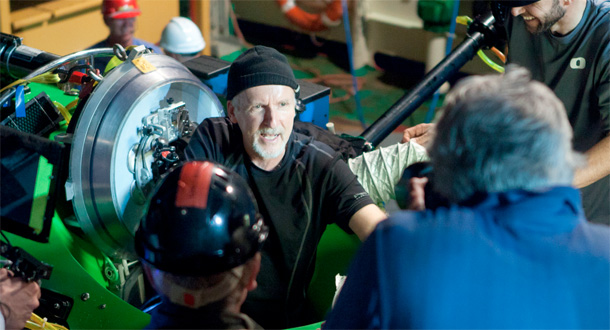Record-Breaking Dive

Solomon Sea, south of New Britain Island, Papua New Guinea
“DEEPSEA CHALLENGER had both booms extended and all her lights blazing,” said underwater photographer Simon Christidis. “I tracked her downward until she was swallowed by the darkness.” Simon was at a depth of a 100 feet (30 meters), filming with his 3-D camera, when the tall green sub began her record-breaking second descent into the New Britain Trench.
Jim was inside the crew sphere. A few minutes earlier, he had finished the final checks of his life-support systems and positioned the spotlight and boom camera to give him a wide-angle view of the sub’s exterior. His camera recorders were running. Six minutes after leaving the surface, he was at 1,660 feet (506 meters) moving downward at four knots. He called out his depth and descent rate to the communications teams in the RHIB and Mermaid Sapphire; his voice was faint, but clear.
Jim had descended through these dark waters three days earlier but ran into technical problems at 23,818 feet (7,260 meters) and decided to return to the surface. On this second dive, he passed through now familiar depth marks: Titanic at 12,500 feet (3,810 meters), Bismarck at 16,000 feet (4,877 meters), and the maximum working depth of the Mir subs at 20,000 feet (6,096 meters). The last part of his journey into the New Britain Trench took him into a world of submerged cliffs, valleys, plains, and plateaus. Two hours and 15 minutes after leaving the surface, he was approaching the bottom at a historic 26,972 feet (8,221 meters).
The fact that Jim had just broken his own records of the deepest diving submersible and deepest solo dive didn’t interest him. As always, his focus was on extreme-place exploration, extreme-image filmmaking, and extreme-depth science. When he first saw the flat, featureless seafloor he slowed his speed to half a knot. He gave a short braking burst with his vertical thrusters and saw veils of sediment as fine as cigarette smoke rise up beneath the sub. This is going to be interesting, he thought.
His touchdown point was on a 3,000-foot-wide (914-meter-wide) basin between two steep slopes. There were no apparent currents. Jellyfish the size of small dinner plates floated in the clear water. One of them, wearing a skirt of dusty sediments around its waist, drifted toward the sub and bumped into the science door. Jim steadied the sub and used its manipulator to take a contingency core sample of the superfine sediments.
His first objective was to rendezvous with lander Mike. He drove 150 feet (46 meters) in Mike’s direction and stopped. The sub’s sonar wasn’t working. He tried to troubleshoot the problem, but it soon became apparent that there was nothing he could do to bring the sonar to life. Without the sonar, he had to be more cautious; his forward motion was limited by the horizontal distance he could see through the water—about 70 feet (21 meters). He thought about conducting a box search for the lander but figured it would take too much time and use too much power. He shifted to plan B.
Jim turned the sub to a 180-degree heading and began to drive toward the south wall of the basin, a 700-foot-high (213-meter-high) escarpment of sediment-covered rocks. As he passed over the flat, tan-colored plain he saw tracks, trails, and mounds. He spotted a waterlogged tree branch, half a coconut, and wood parts that might have come from a small boat. Every few minutes he checked the status of his life-support system and power supply.
Suddenly, he saw the boundary of sediments and clay marking the foot of the slope. Compared to the absolutely flat surface of the “ponded” sediments beneath him, it looked like a gently sloping beach. There was something about its color and texture that reminded him of the boundary of a dry lakebed. He slowed the sub and adjusted his cameras and lights. He was entering high country—a place of potentially overhanging ledges. As soon as he left the beach the slope increased sharply, forcing him to apply more power to his vertical thrusters.
The steep slope had horizontal ridges of dark rocks covered with slumped sediments. There were large rocky outcrops and places similar to sand hills. The gradient increased from 30 degrees to 50 degrees to almost vertical. Soon after he started his climb, he saw a paper-white anemone the size of his hand. The suspension-feeding creature was attached to a dark rock. As he proceeded cautiously upward, he saw clusters of two and three anemones, sometimes dozens, their slim columnar bodies and rings of tentacles leaning toward the light of his passing.
When he reached the plateau at the top of the escarpment, he tried to pick up a fist-size rock with the manipulator. He extended the sub’s mechanical arm and opened its jaws, but they refused to close. He drove the sub forward to get a better purchase and tried again. The jaws stayed open and the rock remained in place. He made a quick assessment of his status. He’d been on the seafloor for three hours. He was low on power and the manipulator’s hydraulic system was erratic. He’d lost communication with the surface. It was time to come up.
Jim took two minutes to point the boom camera down toward the lower pod and drop his twin 450-pound (204-kilogram) ascent weights. The DEEPSEA CHALLENGER rose quickly, leaving a “rocket trail” of sediment pouring out of the lower pod behind her. It took her 59 minutes to cover the five miles (eight kilometers) to the roof of the ocean. She broke through the surface, settled back into the sea, and rose up until the tip of her green sail was clearly visible. Far to the north, an anvil-shaped thunderhead tossed random lightning bolts into the Solomon Sea.
Photograph by Joe MacInnis



